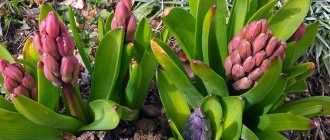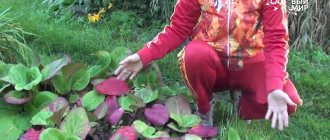In early spring, when the snow has not yet melted in dachas and gardens, low primroses appear. Scientifically, these plants are called saffron. But in floriculture they are better known as crocuses. India is considered the birthplace of saffron; it later spread to most of Europe and Asia.
First spring crocuses
This plant was known back in Ancient Egypt and Greece. Homer and Hippocrates wrote about saffron. The flower was used as an expensive medicine and dye. Crocus stigmas contain a yellow substance that gives a yellow tint to butter, cheeses, and soft drinks. No wonder the word “saffron” has Arabic roots and is translated as “yellow”. Introduced to Europe, the flower found its place in the heraldry of the House of Bourbon, and in Foggy Albion the city was even named after this plant - Saffron. Saffron is also the most expensive spice in the world.
Crocuses: flower features
Crocuses belong to the saffron genus and are part of the large Iris or Kasatikov family. Scientists have described eight dozen species and three hundred varieties of crocuses. A number of them were included in the Red Book. Like numerous relatives, saffron is a corm plant that can delight its owners with bright flowering for many years.
Crocus bud
Saffron corms usually have a flattened or round shape with a diameter of 3 cm. The stem of the flower is undeveloped, and narrow leaves grow directly from the root. Each plant produces a single flower, sometimes 2–3 buds appear. The flowers are goblet-shaped and reach 2–5 cm in diameter. There are two large groups based on color: yellow-flowered with various shades and blue-flowered. The latter have shades ranging from pale and almost white to dark purple. There are albino species and bicolor varieties; spotted buds are less common. Crocuses bloom from 15 to 20 days . Plant height ranges from 8 to 10 cm.
After flowering, fruits appear in place of the bud - boxes in which small, angular seeds ripen.
Features of cultivation
Crocus flowerbed
Crocuses are unpretentious in cultivation and care, they reproduce easily, which is why they are popular even among novice gardeners. Plants are used in the garden for decorative design of alpine slides and flower beds; saffron also looks good in regular group plantings next to other perennials. The spring flowering period of saffron is somewhat limited; the buds bloom while the snow is melting. But today there are also hybrid varieties that bloom until the end of May. There are also species that decorate gardens in autumn.
Growing spring and autumn varieties differs only in the time of planting crocuses in open ground, the dates of fertilization and digging. In everything else: care, watering, soil requirements - everything is done the same.
Spring-blooming crocuses begin their annual cycle with the last weeks of winter and the beginning of spring. Their first shoots appear. The dormant period occurs from mid-June to autumn. This stage is just right for digging up and transplanting bulbs. Crocuses that continue to grow begin to awaken and actively accumulate nutrients in the fall.
Fall-blooming crocuses begin their annual cycle in August. The plant first produces a peduncle, and only then leaves appear. At this time, the formation of the bulb occurs. The dormant period for these types of saffron begins somewhat earlier than for other flowers. If necessary, corms of autumn-blooming crocuses are dug up and replanted almost all summer.
Origin
Crocuses are mysterious flowers; they are covered with various legends and myths. One ancient Greek myth tells of Mercury accidentally killing his friend Crocus. And at the request of Mercury, the gods perpetuated the memory of Crocus. Flowers grew where the young man shed his blood. Every spring these flowers were a reminder of eternal memory.
Another myth is about the young man Crocus, who fell in love with a beautiful nymph. The girl got bored with the passionate courtship, and she turned to the gods. And they turned the young man into a delightful purple flower with deep orange anthers, symbolizing fiery passion.
The flower has two names:
- crocus, from the ancient Greek kroke (thread) - the stigmas of the flower resemble fibrous threads;
- saffron - from Arabic sepheran (yellow).
The Arabs were the first to grow crocuses in the East. Potions and seasonings were prepared from flowers, but they were valued as a natural dye. In ancient China, there was a ban on the use of saffron dye, as it was intended only for the imperial family.
In Europe, the flower became known in the 11th century. It was bred only for economic purposes. The first decorative crocus was brought out only in the 16th century. The country of origin of the flower is considered to be Kashmir (India). According to Buddhist legends, the crocus to Kashmir was sent from heaven by the arhat Nimatun himself. In Tibet, the precious flower is used to produce Tibetan smoking sticks.
Selecting a site for planting
Flowers need a spacious garden plot where they will have plenty of room to grow. The site for planting crocuses in open ground is selected taking into account good lighting. Sites near trees and bushes are also suitable, because the appearance of foliage is still a long way off. You should not plant flowers in places where there is constant shadow. Here the crocuses will be uncomfortable, they will develop poorly and bloom little. To accompany the flowers, choose short and medium-sized perennials: hostas, peonies, ivy and others.
Crocuses prefer sunny places in the garden
The planting site should not be in a lowland; crocuses are not suitable for places with stagnant melt or rainwater. Flowers grow well in fertile soils with good drainage. Light loams are perfect. If the soil on the site is heavy, adding sand, compost, and fine gravel will help improve its quality. Lime is added to acidic soil. It is advisable to fertilize soils that have lost fertility in advance. Compost or humus is placed in the planting holes.
Planting crocuses in spring and autumn
Crocus bulbs
Depending on the variety and type of saffron, flowers are planted in open ground at different times. Indeed, in addition to crocuses that bloom in early spring, specimens that produce buds in the fall are also grown on plots.
Approximate dates for planting crocuses:
- From the beginning of summer until almost August - for autumn bloomers . Flowering will occur in September - October.
- From mid-August to early October - for spring bloomers . Buds appear already in March and April.
If you purchased a plant with an open bud, the flower must be cut off when planting. Otherwise, the crocus will have little chance. If such a plant takes root, it will slow down in growth and will be able to bloom only after a year. But it will come into full force only after 2 years. With this development of events, the leaves and flowers of the crocus are removed, and the flower itself is left alone. Therefore, in order for plants to please with flowering in the same year, saffron is purchased in bulbs.
Industrial Applications
Saffron, obtained from the crocus flower, is used by chefs and cooks around the world. The stigmas are used for cooking.
Another plant that is used in industry is calamus.
To produce 1 kilogram of product, 200 thousand spring crocuses are required. The collection is carried out before sunrise, after which the spice is packaged.
Obtaining and preparing seasoning is a complex, multi-step process, so the cost of the spice is high. On average, one kilogram costs $500–1000.
But this is beneficial, since the seasoning is used in small volumes. The product is also used as a medicine. An overdose of spice is dangerous for the body, so be careful when preparing food.
Preparing and planting corms
Processing bulbs in potassium permanganate
To get a healthy plant, in addition to proper care, you need to choose good planting material. Crocuses are planted with corms. When purchasing them in stores or on the market, you should pay attention to their appearance.
You should refuse to purchase if the bulbs have the following signs:
- rotten areas;
- dark spots;
- mechanical damage.
If, after all, there are damaged specimens in the planting material, then they need to be sorted out. Obviously rotten ones should be thrown away, and small wounds on the bulbs can be treated with ash.
Before planting in open ground, corms are soaked in a special product to prevent various diseases. There are now many such preparations; they are purchased in stores for gardeners and summer residents. The simplest thing is to keep the planting material in a solution of potassium permanganate.
Autumn planting of crocus bulbs
Plant the bulbs to a depth of 6-10 cm with the bottom down. A distance of up to 10 cm is left between plants. It is not recommended to plant flowers closer; in a few years entire families of crocuses appear on the plot. The bulbs are sprinkled with earth on top and watered.
Planting crocuses under the lawn
There is another way to plant. If you want to get neat flowers on the lawn, then you need to open the turf like a book leaf, loosen the soil and root the bulbs. Then the ground is watered and the lawn layer is put in place.
Crocus care
Saffron thrives in the wild. Therefore, complex care for crocuses in open ground is not required.
A distinctive feature of saffron is its ability to survive in dry weather. But in this case, the height of the flowers will be slightly smaller.
Crocuses prefer loose soil
In order for crocuses to develop and bloom well, the following rules should be followed:
- Plants practically do not need watering. They bloom in early spring, when the ground is still saturated with moisture from melted snow. Additional watering is required only in case of little snow winter. But even without receiving moisture, the flowers still continue to develop, but grow smaller.
- Although wild saffron is a drought-tolerant plant, it requires regular watering in the garden. Lack of moisture during the period of active growth will affect the size of the bulbs and subsequent flowering.
- Care must include loosening the growing area and weeding.
- Leaves are removed from the plant only when they are completely dry.
- After the ground part of the crocuses dies, the soil can be mulched if desired. For this, compost, peat, and sawdust are used.
- After 3–4 years, crocuses are planted due to the appearance of children. This is done during the summer.
Feed flowers during intensive growth. The plant especially needs phosphorus and potassium. And nitrogen-containing fertilizers should be handled carefully, as large quantities can provoke the appearance of fungal diseases. Fertilizing in the form of a complex fertilizer is applied twice a season: in the spring while there is still snow (up to 40 g per square meter) and during the period of budding and flowering.
Transfer
Transplanting crocus bulbs
Unlike its close relatives, whose bulbs must be dug up for storage, crocus is not so scrupulous in matters of wintering. The plant tolerates cold well in open ground. But it is still advisable to dig up corms once every few years, at least to plant them. Several babies (from 1 to 10 pieces) are constantly growing on the mother's bulb. Crowding during development leads to a decrease in flower size. To obtain large planting material, bulbs are dug more often.
The corms removed from the soil are sorted and sorted, and checked for diseases. They are then sent for drying and storage or replanted. Crocuses are transplanted during the summer dormancy period. Thus, planting of spring-blooming specimens is carried out no later than the end of September, and autumn-blooming specimens - until mid-August.
It must be remembered that crocuses can also reproduce by self-sowing. And if you don’t take care of the plant, after a few years the owner of the site runs the risk of getting not a cultivated plant, but an annoying weed that grows anywhere.
When to dig them up
As already mentioned, replanting is carried out every three to four years, but if you want to propagate flowers around the area or share with a neighbor, you can do this earlier.
If there are autumn-blooming crocuses on your site, then you need to dig them up from June to August, and as for spring-blooming ones, they begin to be dug up in July and until September. Bulbs that have been removed from the ground should be dried, carefully inspected and scales with defects, as well as dead roots, removed. Diseased bulbs should be removed immediately, and if they have slight damage, they should be treated with ash or crushed coal. If you do not plant the bulbs in the ground right away, they should be placed in a cool and dry place.
Reproduction
You can get new plants in two ways: propagation by daughter bulbs and seeds.
Crocus bulbs with “babies”
The first method is simple. Several babies are formed on the mother's bulb. To plant crocuses over a larger area, the bulbs are dug up after 3–4 years. The children are separated from the mother’s body and rooted in new places as during the initial planting. Such a small bulb will bloom after 3-4 years. It is worth noting that vegetative propagation when planting crocuses in open ground allows you to maintain the purity of the variety.
Crocus seeds
The seed propagation method is rarely used, since such plants bloom only after 4–5 years. Typically, spring-flowering saffron is used for this. In flowers that open buds in the fall, the seeds do not have time to ripen.
Briefly about the main thing
So, based on all that has been said, we can draw brief conclusions:
- Crocuses are planted in the fall if they bloom in the spring. Autumn crocuses should be planted in summer.
- The flowering period lasts no more than three weeks.
- Crocuses love bright sunlight, but they also tolerate shade quite well.
- Watering is needed only in rare cases when spring and winter are dry.
- It is better to use complete mineral fertilizers as fertilizing. Organics should not be used.
- Flowers are propagated primarily by dividing bulbs, but spring varieties can also be propagated by seeds.
- Diseases and pests rarely bother saffron.
As you can see, growing these beautiful primroses is quite simple even for beginners. Moreover, now you know everything about how to care for crocuses.
Diseases and pests
Crocuses do not get sick very often, but they can contract a viral or fungal disease, which leads to wilting and in some cases death.
In case of viral diseases, the buds of the flower become deformed and gray spots appear on the petals. The damaged plant should be removed from the site as quickly as possible and destroyed so as not to infect neighboring individuals. When caring for crocuses in the open ground and for the prevention of diseases, they are treated against insect pests, which carry viruses.
Fungal diseases lead to rotting of plants. First, the bulb is affected, it becomes soft and wrinkled. The emerging sprout also becomes sick. The diseased plant is destroyed. Fungal diseases include chlorosis, fusarium, gray and sclerotial penicillium rot . To prevent them, corms are carefully checked before planting for damaged areas. It is also customary to treat seed material with various preparations containing copper.
Crocus pests
Crocuses are harmed not only by insects, but also by rodents: mice and moles. Turntables and special devices with ultrasound help to get rid of the latter. Insect pests (caterpillars, slugs) have to be picked off by hand and destroyed. Plants are also treated with insecticides. This must be done because of the possible threat of viral diseases.
Why don't they bloom
Sometimes gardeners have to deal with the absence of flowers from crocuses planted in the spring. We will find out why this happens further.
Confusion with varieties
Crocuses are divided into autumn and spring flowering. The first should be planted in the spring, the second in the fall. By mixing up planting dates, you may experience a lack of flowering.
Pests
Sometimes the bulbs in the ground are eaten by mice and other rodents. It is clear that crocuses are unlikely to bloom after severe damage.
Excessive division
If the mother bulb has produced too many children, it may not have the strength to flower.
After flowering
Withered crocuses
When caring for crocuses in the open ground, the wilted buds are cut off. But you can leave the foliage, let it decorate the garden with its greenery. Later it will wither on its own. In winter, the area with crocuses can be covered with mulch. To do this, use peat or dry leaves.
If spring-flowering bulbs are intended for digging, then they are removed from the soil in the summer after the leaves have withered. The planting material is dug up, dried, and earthen lumps and dead particles are removed. For storage, place in boxes in one layer. The temperature in a dark, dry room should not exceed 22 °C.
How to store bulbs
The dug up bulbs are placed in a shaded place to dry. Then the remaining soil, dead scales and roots are removed from them. Next, they are placed in a box or drawer, laid in one layer. Very small bulbs can be placed in candy boxes. In the room where the bulbs will be stored until August, the air temperature must be at least 22 degrees, otherwise the process of laying flower buds will be disrupted. At the beginning of August, the room temperature should be reduced to 20 degrees, and after 7 days - to 15 degrees. However, these ideal conditions for storing crocus planting material can sometimes be created only in specialized farms. Amateur gardeners, for storing bulbs, choose a dry, dark room that is well ventilated, and the air temperature there should be room temperature.











